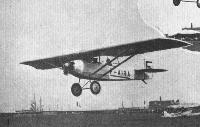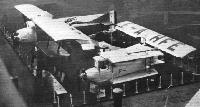
Описание
Страна : Франция
Год : 1925
Двухместный легкий спортивный и учебно-тренировочный самолет
Caudron С.109
С.109, легкий двухместный моноплан с крылом типа парасоль, имел легкий фюзеляж деревянной конструкции прямоугольного сечения с полотняной обшивкой. Все крыло было полностью обтянуто тканью, консоли могли складываться назад для транспортировки либо хранения. Курсант (пассажир) размещался в открытой кабине под центропланом, пилот (инструктор) в кабине сразу за ним, под вырезом в задней кромке крыла. По необходимости мог устанавливаться двойной комплект управления.
Прототип С.109 совершил первый полет в мае 1925 года и снискал некоторый успех, его избрали для своих многоэтапных дальних перелетов такие знаменитости тех времен, как Торе и Дельмот. Самолет также понравился французским женщинам-пилотам, включая Мариз Бастье и Лену Бернштейн.
Серийно изготовили 24 самолета, шесть из них закупили ВВС Франции для использования в качестве связных. Был выпущен ряд незначительно отличавшихся модификаций. После двух машин модификации С.110 выпустили по одному самолету С.112, С.113, С.114, С.116 и С.117.
Вариант
С.109/2: приблизительно в 1950 году единственный уцелевший самолет С.109 (шестая серийная машина) модифицировали в С.109/2, переделав его под звездообразный мотор Salmson 5Aq мощностью 85 л.с. (63 кВт)
ТАКТИКО-ТЕХНИЧЕСКИЕ ХАРАКТЕРИСТИКИ
Caudron С.109
Тип: двухместный легкий спортивный и учебно-тренировочный самолет
Силовая установка: один звездообразный мотор Salmson AD 9 мощностью 40 л. с. (30 кВт)
Летные характеристики: макс, скорость на уровне моря 126 км/ч; продолжительность полета 4 ч
Масса: пустого 328 кг; максимальная взлетная 555 кг
Размеры: размах крыла 11,50 м; длина 6,15 м; высота 2,27 м; площадь крыла 20,00 м!
Описание:
- Caudron С.109
- Flight, August 1925
THE 1925 VAUVILLE MEETING - Flight, December 1926
The Paris Aero Show 1926
Фотографии
-
Мировая Авиация 84
Центроплан крыла самолета C.109 опирался на 4 короткие вертикальные стойки, установленные вокруг передней кабины пилота, тогда как его консоли крепились к нижним лонжеронам фюзеляжа парой дюралевых подкосов по каждому борту.
-
Flight 1930-01 / Flight
The little Caudron C.109 (Salmson) which Lt. de Vaisseau Sala uses.
-
Air Pictorial 1958-03 / Air Pictorial's photo-review
Регистрационный номер: F-PFLN The venerable Caudron C.109 (F-PFLN) of 1928 - rebuilt 1950. The Caudron C.109 is owned by the Aero Club de Perreux et de la Banlieve.
-
Flight 1925-08 / Flight
Регистрационный номер: F-ESAG THE RUNNER-UP: The Caudron monoplane, type C.109, with 40 h.p. Salmson engine. In the upper right hand corner, M. Talpin, chief designer to the Caudron works, and, in the lower left-hand corner, M. Vanlaere, pilot of the machine.
-
Flight 1928-09 / Flight
Регистрационный номер: F-AITI [2] M. Finat's Caudron monoplane which he got off in the shortest distance during the take-off tests (91 metres).
-
Flight 1928-09 / Flight
Регистрационный номер: F-AITI [2] TAKING OFF AT ORLY: (3) The Caudron (Salmson) monoplane, piloted by M. Finat.
-
Flight 1928-07 / Flight
Регистрационный номер: F-AIRA AT THE ROTTERDAM LIGHT 'PLANE MEETING: The take-off and landing competition. 4. The Caudron monoplane taking off.
-
Flight 1926-12 / Flight
Регистрационный номер: F-AHFE The Caudron Stand: The large machine is the C.104, two-seater fighter, while the smaller types include training machines and a light monoplane two-seater, the C.109.
Другие самолёты на фотографии: Caudron C.101 / C.103 / C.104 / C.107 - Франция - 1925
-
Flight 1926-12 / Flight
The slot for the undercarriage axle is formed by a short welded-on tube on the Caudron C.109 parasol monoplane two-seater light 'plane.
- Фотографии








